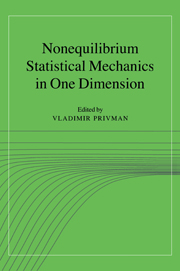Book contents
- Frontmatter
- Contents
- Contributors
- Preface
- Part I Reaction-Diffusion Systems and Models of Catalysis
- Part II Kinetic Ising Models
- Part III Ordering, Coagulation, Phase Separation
- Part IV Random Adsorption and Relaxation Processes
- Part V Fluctuations in Particle and Surface Systems
- Part VI Diffusion and Transport in One Dimension
- Part VII Experimental Results
- Index
- Abbreviations
Part IV - Random Adsorption and Relaxation Processes
Published online by Cambridge University Press: 18 December 2009
- Frontmatter
- Contents
- Contributors
- Preface
- Part I Reaction-Diffusion Systems and Models of Catalysis
- Part II Kinetic Ising Models
- Part III Ordering, Coagulation, Phase Separation
- Part IV Random Adsorption and Relaxation Processes
- Part V Fluctuations in Particle and Surface Systems
- Part VI Diffusion and Transport in One Dimension
- Part VII Experimental Results
- Index
- Abbreviations
Summary
Editor's note
The next three chapters cover the topics of monolayer adsorption and, to a limited extent, multilayer adsorption, in those systems where finite particle dimensions provide the main interparticle interaction mechanism. Furthermore, the particles are larger than the unit cells of the underlying lattice (for lattice models). As a result, deposition without relaxation leads to interesting random jammed states where small vacant areas can no longer be covered. This basic process of random sequential adsorption, and its generalizations, are described in Ch. 10.
Added relaxation processes lead to the formation of denser deposits, yielding ordered states (full coverage in 1D). Chapter 11 is devoted to diffusional relaxation. The detachment of recombined particles is another relaxation mechanism, reviewed in Ch. 12. The detachment of originally deposited particles, although modeling an important experimental process, has been studied much less extensively.
While several exact results are available, as well as extensive Monte Carlo studies, it is interesting to note that many theoretical advances in deposition models with added relaxation have been derived by exploring relations to other 1D systems. These range from Heisenberg spin models to reactiondiffusion systems (Part I). However, most of these relations are limited to 1D.
Besides their theoretical interest, 1D deposition models find applications in characterizing certain reactions on polymer chains, in modeling traffic flow, and in describing the attachment of small molecules on DNA. The latter application is described in Ch. 22.
- Type
- Chapter
- Information
- Nonequilibrium Statistical Mechanics in One Dimension , pp. 203 - 204Publisher: Cambridge University PressPrint publication year: 1997



